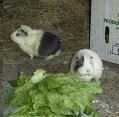 |
Bungala Ridge Permaculture Gardens REDUCE ... REUSE ... RECYCLE ... REPAIR ... RETURN ... REVEGETATE ... REPLENISH |
||||||||
|
|||||||||
|
|
The Role of Patterns Copyright © Beverley Paine July 2002 Most people think of permaculture as a gardening system, but it's more than that. It's short hand for 'permanent culture' and relies on sustainable practice in everything, not just agriculture. Permaculture focuses on the production of food because it is central to human life, and in doing so it touches just about every other area of life. Permaculture is about designing sustainable human settlements, by drawing on the study of interrelationships and interdependence of living things in the natural world. Working with nature and understanding the overall interlocking patterns and the way they interweave and connect, to produce sustainable and successful outcomes, are key design principles of permaculture practice. Bill Mollison's book "Permaculture: A Designer's Manual" is a must for those wanting to understand the design principles and ethics behind permaculture practice, rather than simply applying the many wonderful ideas like mandala gardens and keyhole beds. Bill devotes a whole chapter to the study of patterns, which underlie everything in nature. Understanding how these patterns give rise to simple and complex relationships between the various elements in any system can help to develop eco-friendly energy efficient solutions. And energy efficiency is what every permaculture system aspires to. The goal is to achieve outputs greater than the inputs, then return that surplus to the system. The best way to do this is to continually look at how we can cut the energy cost of the input. This is where the motto "reduce, reuse, recycle, repair, and return" comes in handy, to remind me to look for innovative and lost cost (overall energy not just monetary), solutions to design problems. This approach works well, not only in the garden, but when I'm building a work shed, designing a kitchen, planning the layout of my office, organising my day - any where I'm expending energy, which is all the time. I ask myself "Am I getting the best, cost efficient (in energy terms), result?" and "Do my actions comply with the permaculture ethics of care of the earth, care of people and return of surplus?" These, and my understanding of how patterns underlie and effect everything we do, guide me in my permaculture life.
|
Hot Links!
This site is sponsored by |
|||||||
|
|
|
|
|||||||




